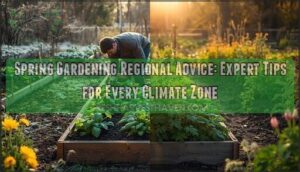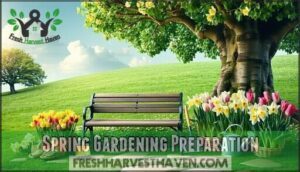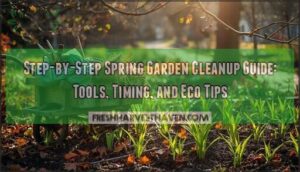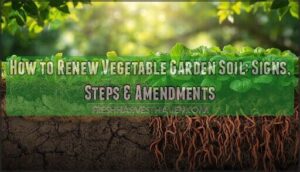This site is supported by our readers. We may earn a commission, at no cost to you, if you purchase through links.

Cold-hardy crops like spinach and peas thrive in northern zones by early spring, while southern gardeners can plant warm-season vegetables weeks earlier.
Check your last frost date—it’s your gardening GPS for timing everything from soil preparation to seeding.
Cool-season flowers like pansies handle temperature swings better than impatiens, which need consistent warmth.
Native plants adapted to your region require less water and maintenance than exotic varieties.
Smart gardeners also consider microclimates in their yards—that sunny south-facing wall might support plants from one zone warmer.
The secret lies in working with your local conditions rather than fighting them, which is the key to successful gardening and understanding your local conditions.
Table Of Contents
- Key Takeaways
- Spring Gardening Preparation
- Regional Plant Selection
- Soil Preparation Techniques
- Garden Maintenance and Care
- Spring Planting and Gardening
- Frequently Asked Questions (FAQs)
- What is the 3 year rule in gardening?
- What is the most common mistake of first time gardeners?
- Should you plan a Spring Garden?
- How do I prepare my garden for spring?
- When is the best time to start Spring Gardening?
- Should you write a Spring Gardening checklist?
- Is March a good time to start a garden?
- Should I plant a new lawn this spring?
- When should I start my vegetable garden seeds?
- How do I protect young plants from frost?
- Conclusion
Key Takeaways
- Match plants to your climate zone and frost dates – You’ll succeed when you choose cold-hardy crops like spinach for northern zones and warm-season varieties for southern regions, timing everything around your last frost date.
- Work with your local conditions instead of fighting them – You’ll save time and water by selecting native plants adapted to your region’s natural rainfall and temperature patterns rather than exotic varieties that need constant maintenance.
- Use microclimates to expand your growing options – You can grow plants from one zone warmer by utilizing sunny, protected spots like south-facing walls that create warmer pockets in your yard.
- Prepare your soil based on regional variations – You’ll need different approaches depending on your location, from adding lime to acidic Northeast soils to improving drainage in clay-heavy Midwest earth.
Spring Gardening Preparation
Spring preparation sets the foundation for your garden’s success this year.
Start by reviewing last season’s notes and photos to identify what worked well and what needs improvement in your specific growing zone.
Reviewing Previous Seasons
Your garden journal holds journaling benefits that reveal next season’s success.
Past seasons whisper secrets that smart gardeners never ignore.
Last year’s photos reveal bloom trends and crop performance patterns you might’ve missed. Analyze those gardening mistakes—wilted tomatoes or sparse flower beds tell stories.
To make certain tools are ready, remember to inspect and clean your garden tools before the busy season. This mistake analysis becomes your roadmap for layout changes and better regional gardening advice this spring.
Organizing Photos and Notes
Transform scattered memories into organized wisdom through thoughtful Photo Organization and Note Categorization.
Sort your gardening notes by plant type, bloom periods, or garden zones for easy reference.
Digital Archiving preserves valuable insights while enabling Seasonal Comparisons between years.
Document successes, failures, and unexpected discoveries with clear labels.
This Memory Preservation system becomes your personal regional gardening database, turning casual observations into actionable gardening advice that guides future planting decisions with confidence.
Identifying Gaps in Bloom Sequences
Once your photos and notes are organized, spotting those dreaded bloom gaps becomes easier.
Your garden shouldn’t look like a patchwork quilt with missing pieces.
Here’s how to identify timing issues for better seasonal color:
- Mark calendar dates when flowers fade completely
- Note which garden sections look bare during specific months
- Track bloom timing patterns across different plant varieties
- Identify peak flowering periods versus dormant stretches
- Document succession planting opportunities for continuous interest
Smart regional plant selection fills these voids perfectly.
Planning Garden Layout and Crop Rotation
Sketching your garden layout starts with mapping Sun Exposure and Water Access across your space.
Crop rotation prevents soil depletion while Companion Planting maximizes yields.
Group plants by watering needs and growth habits for Space Optimization.
This strategic approach delivers Rotation Benefits that’ll boost your harvest and simplify maintenance throughout the growing season.
Regional Plant Selection
Choosing the right plants for your region transforms your garden from surviving to thriving.
Each climate zone offers unique opportunities, from hellebores that brave late winter in cold regions to heat-loving zinnias that flourish in southwestern gardens, allowing your garden to go from merely surviving to thriving.
Your garden’s success starts with choosing plants that love your local climate, not fight it.
Late-Winter and Early-Spring Bloomers
Four brilliant blooms can break winter’s grip on your garden. Early spring champions defy frozen soil to deliver color when you need it most.
- Hellebore Varieties: Christmas and Lenten roses bloom through snow, offering whites, pinks, and purples from December through March.
- Snowdrop Types: Single and double galanthus push through frozen ground, creating carpets of drooping white bells.
- Winter Aconites: Bright yellow buttercup-like flowers emerge with distinctive green ruffs, often blooming alongside snowdrops.
- Crocus Colors: Purple, white, and yellow crocuses signal spring’s arrival, with some varieties blooming in late winter.
These latewinter bloomers and earlyspring bloomers provide regional spring florals perfectly suited as climate plants.
Early Irises join the parade in warmer zones.
Regional advice: plant these fall-planted treasures for reliable winter color.
Outstanding Spring Plants by Region
Each region offers distinct Native Spring Blooms with specific Regional Bloom Times perfectly suited to local conditions.
Climate-Adapted Plants like Northeast peonies, Southeast zinnias, Midwest coneflowers, and Southwest California poppies showcase Unique Regional Varieties that thrive naturally.
These Cold-Hardy Options eliminate guesswork in spring gardening by matching your local climate needs.
Consider early planting strategies to avoid transplant shock.
Smart regional advice means choosing plants that flourish rather than fight your zone’s seasonal planting patterns.
Shopping-List Plants for Each Region
Your success depends on matching plants to your gardening climate zones and planting dates. Smart shoppers focus on Native Plant Focus varieties that thrive locally. Cold-Hardy Varieties work best for northern regions, while Drought-Tolerant Choices suit arid areas.
Check gardening regional maps before shopping.
Here’s your Regional Bloom Times shopping strategy:
- Northeast: Grab peas, spinach, beets, carrots, and lettuce for early spring direct sowing
- Midwest: Stock up on snap beans, prairie smoke, and swamp milkweed for late spring planting
- Southeast: Load your cart with carrots, beets, collards, and sweet potatoes for February starts
- Western: Choose lettuce, spinach, kale, and drought-tolerant beans for coastal conditions
- Central Plains: Buy peas, radishes, tomatoes, and peppers for staggered spring plantings
Consider adding the Black-Eyed Susan to your garden. Follow Varietal Shopping Tips from gardening regional events for best results.
Unique Plant Species for Different Climates
While some gardeners stick to familiar varieties, climate-adapted cultivars reveal your region’s hidden potential.
Microclimate gardening lets you experiment with unique plant species that thrive in your specific conditions.
Native plant benefits include natural pest resistance and reduced water needs.
Consider regional endemics like Texas Persimmon for the Southwest or Trillium for moist eastern areas.
These selections support biodiversity conservation while building climate resilience.
Check gardening regional maps and zone gardening tips to discover your area’s specialty plants that mainstream catalogs often overlook.
Soil Preparation Techniques
Your soil is the foundation of garden success, so you’ll want to prepare it properly before planting begins.
Start by testing your soil’s pH and nutrient levels, then add organic matter like compost to create the ideal growing environment for your plants, which will help achieve garden success.
Dividing Perennials and Rejuvenating Plants
Breaking down overgrown perennials reveals your garden’s hidden potential. Division Benefits include multiplied plants and renewed vigor. Perfect Rejuvenation Timing occurs during dormancy when plants conserve energy.
Choose sharp, clean tools for precise cuts that promote healing. Knowing where to source specialized garden implements can be invaluable.
Essential steps for dividing perennials:
- Tool Selection – Use sterilized spades and pruning shears
- Gentle extraction – Lift entire root clumps carefully
- Post-Division Care – Water thoroughly and mulch divisions
This Plant Propagation technique transforms tired clumps into thriving colonies, giving you spring gardening tips that deliver zone gardening results.
Checking Soil Quality and Adjusting PH Levels
After dividing your perennials, it’s time to discover what’s happening beneath the surface. Soil Testing Kits from your Extension Office reveal the hidden story of pH levels and Nutrient Deficiency Signs that determine your garden’s fate.
| pH Range | Garden Impact |
|---|---|
| 6.0-7.0 | Ideal nutrient uptake |
| Below 6.0 | Iron toxicity, stunted growth |
| Above 7.5 | Phosphorus lockout |
| 6.5 | Peak 30% nutrient boost |
| Acidic soils | Need lime treatment |
Regional Soil Variations mean your neighbor’s success won’t guarantee yours. Sandy soils in the Southwest drain fast, while clay-heavy Midwest earth holds nutrients longer.
pH Adjustment Methods like lime for acidic conditions or sulfur for alkaline problems transform struggling plots into productive gardening zones. Organic Amendments Impact shows within months, creating the foundation for thriving plants.
You can find a variety of testing products available for purchase online.
Adding Compost or Well-Rotted Manure
Two key ingredients transform average dirt into garden gold.
Compost benefits your spring garden planning by providing essential nutrients through natural nutrient cycling.
Here’s your soil enrichment game plan:
- Layer 2-3 inches of finished compost across beds before planting season
- Choose manure types like aged cow or chicken for different gardening zones
- Mix application methods – work into soil or side-dress established plants
This garden soil preparation creates the foundation for thriving plants through effective nutrient cycling.
Ideal growth requires understanding ideal soil pH.
Garden Maintenance and Care
Spring’s arrival signals it’s time to assess your garden’s winter damage and prepare for the growing season ahead.
You’ll need to tackle essential maintenance tasks like pruning, cleaning, and pest control to set your plants up for healthy growth.
Pruning and Trimming Trees and Shrubs
With healthy soil ready, your trees and shrubs need strategic pruning to thrive. Pruning timing matters—cut dormant trees in late winter before buds swell, while spring bloomers get shaped after flowering.
Sharp tool selection prevents plant damage and speeds healing. Clean cuts at 45-degree angles promote proper wound treatment. Follow safety practices by wearing gloves and checking for power lines.
A key aspect of tool selection involves choosing the right shears for clean cuts. This spring pruning guide transforms overgrown shrubs into garden showstoppers through proper shrub shaping and trimming techniques.
Removing Dead and Tattered Leaves
Dead leaves cluttering your garden signal it’s time for spring garden maintenance. This essential step prevents disease prevention issues and improves aesthetic appeal while supporting healthy plant growth.
Here’s your action plan for removing winter’s leftovers:
- Gently pull away brown, crispy foliage – Focus on obviously damaged leaves while preserving healthy green growth
- Inspect plants for pest control needs – Look for signs of insect damage, fungal spots, or unusual discoloration
- Leave some debris strategically – Maintain small piles near plants to support beneficial insects during change
Proper dead leaves removal enhances air circulation around plants and creates space for fresh mulch benefits. Remember to check for local frost patterns before removing protective debris. This spring pruning guide step sets the foundation for successful gardening by season, ensuring your plants start strong and stay healthy throughout the growing period.
Cleaning Up Flower Beds and Protecting Beneficial Insects
While those brown stems and withered leaves look unsightly, they’re actually winter hotels for beneficial insects.
Wait until temperatures consistently reach 50°F before tackling flowerbed debris cleanup. Native bees, butterflies, and other pollinators need these natural insect habitats to complete their life cycles.
When you do clean up, work gradually—remove debris in sections over several weeks rather than all at once. This approach supports pollinator support while maintaining your spring flower care routine.
Leave some stems standing until late spring to provide continued shelter. Smart gardening by season means timing your mulch timing around these beneficial insects’ needs, creating natural pest control partnerships in your flower beds.
Controlling Pests and Diseases With Horticultural Oil
Why let pests and diseases wreck your spring garden when horticultural oil offers safe, effective protection? This organic solution suffocates soft-bodied insects and disrupts fungal growth without harming beneficial insects when applied correctly.
- Oil Application Timing: Apply dormant oil in late winter before bud break for maximum pest control effectiveness
- Oil Spray Coverage: Verify complete plant coverage since horticultural oil only works through direct contact with pests
- Mixing Oil Solutions: Use 3% concentration for dormant applications, 1-2% for growing season treatments
Spring Planting and Gardening
Now you’re ready to transform your garden from winter’s dormant state into a thriving spring paradise.
This pivotal planting season sets the foundation for months of fresh vegetables, colorful blooms, and bountiful harvests that’ll reward your efforts all summer long.
Planting Vegetables and Summer Flowering Bulbs
Your spring planting window opens when soil temperatures reach 45-50°F.
Plant cool-season vegetables like lettuce and peas first, followed by summer-flowering bulbs after your last frost date.
Check planting depth requirements – most bulbs need three times their height in soil depth.
Match vegetable varieties to your growing season length and provide adequate sunlight exposure for ideal growth, considering the growing season length and ensuring the right conditions for ideal growth.
Tidying The Garden and Removing Debris
After winter’s retreat, your garden needs a thorough spring gardening cleanup to reveal its potential.
Clear away fallen branches, soggy leaves, and accumulated debris that can harbor pests and diseases.
This seasonal task creates a clean slate for healthy growth:
- Debris Disposal: Remove all organic matter systematically, checking for pest eggs or fungal issues
- Path Clearing: Sweep walkways and edges, making navigation safer and more appealing
- Tool Cleaning: Sanitize pruners and rakes to prevent spreading diseases between plants.
Proper garden cleanup and weed removal set the foundation for your outdoor tasks success.
Starting or Reviving a Compost Pile
After clearing debris, your compost pile becomes the powerhouse of soil health.
Transform kitchen scraps and yard waste into black gold using proper Compost Materials ratios. Choose the right Pile Location for easy access and drainage. Regular Turning Frequency accelerates decomposition.
| Green Materials | Brown Materials | Compost Activators |
|---|---|---|
| Kitchen scraps | Dry leaves | Garden soil |
| Fresh grass | Paper/cardboard | Wellrotted manure |
| Coffee grounds | Wood chips | Commercial activator |
| Vegetable peels | Straw/hay | Finished compost |
| Plant trimmings | Pine needles | Bone meal |
Balance carbon and nitrogen for ideal spring composting tips success.
Planting Shrubs and Blossom Trees for Year-Round Delight
Your compost now feeds the soil, setting the stage for spectacular shrub selection and blossom varieties that’ll transform your space.
Smart planting techniques and regional adaptations guarantee success when you choose the right plants for your climate zone. A digital soil moisture meter can also help guarantee the best watering.
Here are three key considerations for year-round interest:
- Spring gardening timing – Plant dormant shrubs and blossom trees 4-6 weeks before your last frost date
- Regional gardening tips – Select native varieties like Eastern redbud for cold zones or Southern magnolia for warmer areas
- Planting schedule coordination – Match planting timelines with your area’s growing season for ideal establishment
Frequently Asked Questions (FAQs)
What is the 3 year rule in gardening?
Don’t let impatience trick you—the 3-year rule reveals that perennials "sleep" their first year, "creep" their second, and "leap" their third.
Your plants aren’t failing; they’re establishing strong roots for spectacular future growth.
What is the most common mistake of first time gardeners?
Overwatering kills more plants than anything else. You’re trying to be helpful, but soggy roots can’t breathe and quickly rot, turning your green dreams into brown disappointment.
Should you plan a Spring Garden?
You should absolutely plan your spring garden!
Timing matters – it prevents planting mistakes and helps crops mature before frost.
Planning maximizes your growing season and helps you choose the right plants for your area.
How do I prepare my garden for spring?
Seventy percent of gardeners who prep their soil properly see 40% better yields.
You’ll want to clear debris, test your soil’s pH, and add compost or manure.
Prune dormant plants and divide perennials for healthier growth this season.
When is the best time to start Spring Gardening?
Start spring gardening 2-4 weeks before your last frost date. Plant cold-hardy crops like peas and spinach first, then warm-season vegetables after frost danger passes completely.
Should you write a Spring Gardening checklist?
Like a roadmap guides travelers, you’ll need a checklist to navigate spring’s gardening maze.
Create one covering soil prep, seed selection, timing schedules, and maintenance tasks.
It prevents forgotten steps and guarantees maximum harvest success.
Is March a good time to start a garden?
March works well for starting gardens in most regions, but timing depends on your hardiness zone.
In zones 8-10, you can plant cool-weather crops like lettuce and peas.
Colder zones should wait until April or May to avoid frost damage.
Should I plant a new lawn this spring?
New lawns need 80% less water when established in spring versus summer.
You should plant your new lawn this spring because cooler temperatures and natural rainfall create ideal growing conditions.
The grass develops stronger roots before summer heat arrives, ensuring better survival rates.
When should I start my vegetable garden seeds?
You’ll want to start vegetable seeds indoors 6-8 weeks before your last frost date. Check your zip code’s frost calendar, then count backwards from there to nail perfect timing.
How do I protect young plants from frost?
Frost can damage or kill seedlings in temperatures below 32°F, affecting 85% of tender plants.
You’ll protect young plants by covering them with row covers, cloches, or even old bedsheets during cold nights.
Conclusion
As they say, "the best time to plant a tree was twenty years ago, the second best time is now."
Your spring gardening regional advice starts with understanding your unique climate zone and frost dates.
Success comes from matching plants to your local conditions rather than fighting them.
Check soil temperature, select region-appropriate varieties, and time your plantings correctly.
Remember that microclimates in your yard can support plants from different zones.
With proper preparation and regional knowledge, you’ll create a thriving garden that works with nature.
- https://planthardiness.ars.usda.gov/system/files/VA150_HS.png
- https://go.redirectingat.com/?id=92X1572902&xcust=realhomes_us_1641019188579487881&xs=1&url=https%3A%2F%2Fbillyoh.com%2F&sref=https%3A%2F%2Fwww.realhomes.com%2Fnews%2Fhow-to-get-your-garden-ready-for-spring
- https://www.thespruce.com/spring-gardening-8604152
- https://www.finegardening.com/collection/spring-planting-plans-for-your-region
- https://www.gardeningknowhow.com/planting-zones/virginia-planting-zones.htm




